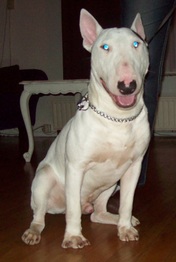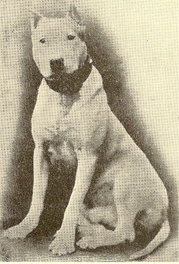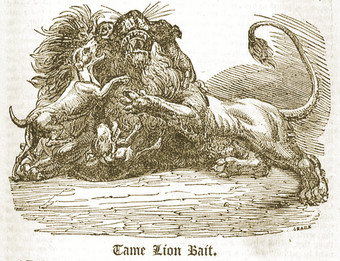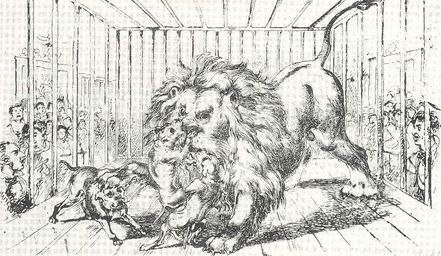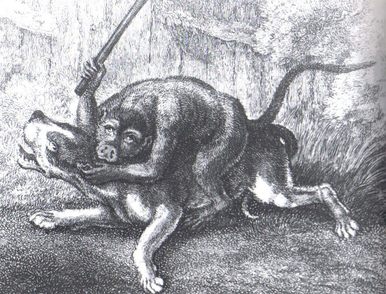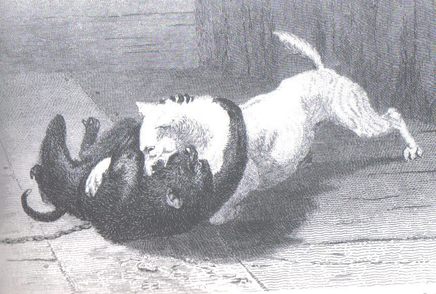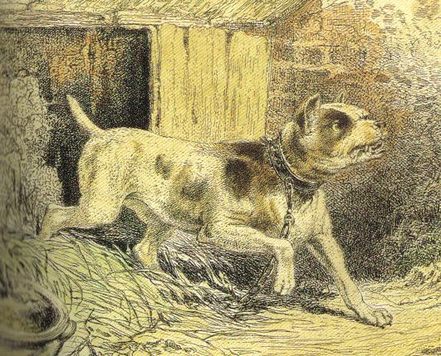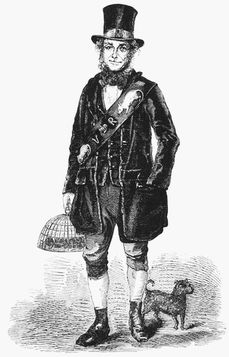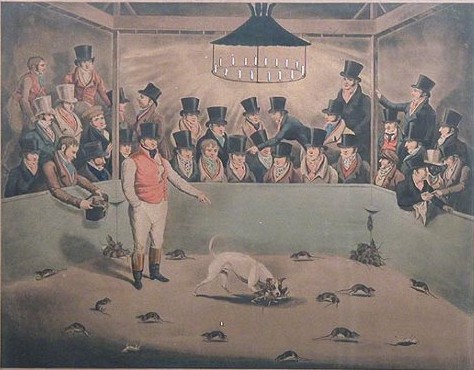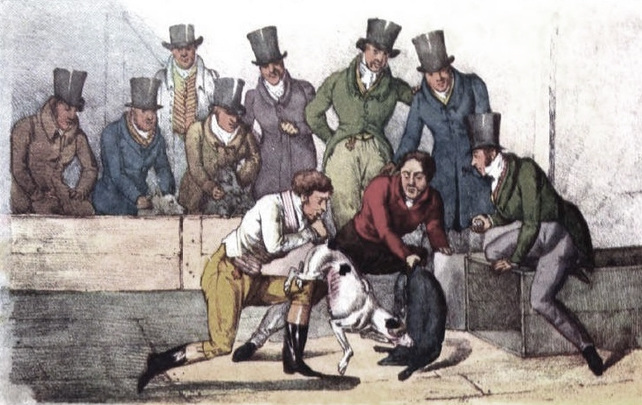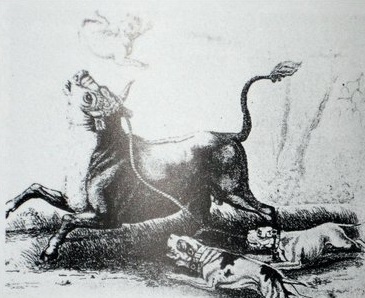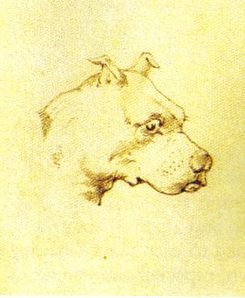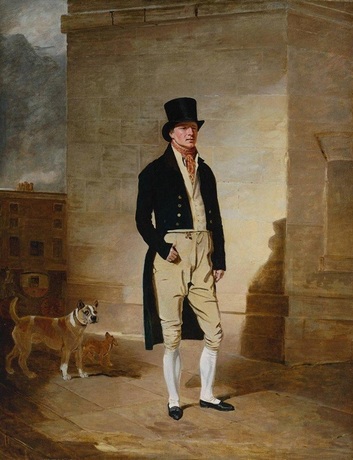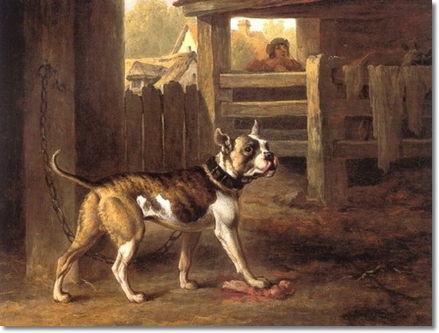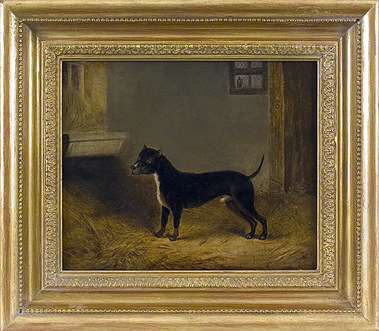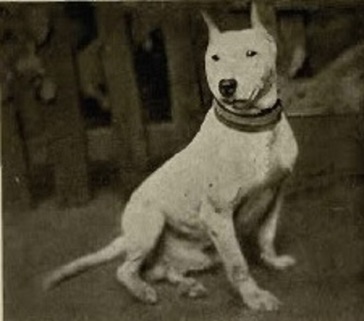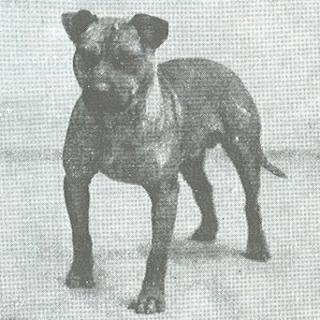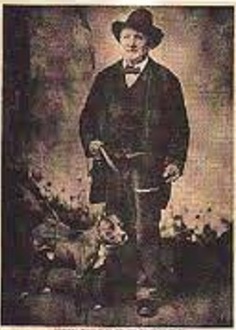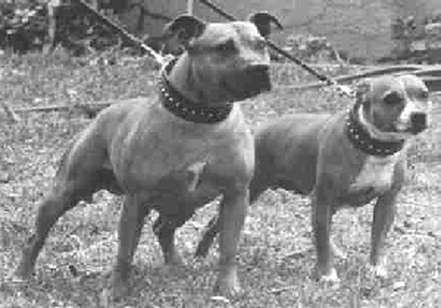Bull & Terriers
Popular but also one of the most controversial type of dogs of today....
Bull & Terriers have a long and bloody history, and however mainly appreciated as great companion dogs, to this very day they also still being used as fighting dogs. Crosses between Bulldogs and Terriers were allready known in the early 18th century and these crosses became the foundation of some very popular dog breeds of today. In this case it's a shared history with 4 closely related breeds, the Amstaff, APBT, Staffordshire Bull Terrier and the English Bull Terrier. Despite all the opinions and prejudices it has to be said that today there is a significant difference between the so-called 'working-line' dogs and the show/companion dogs.
Bull & Terriers existed in many varieties and all kinds of Terriers were used to crossbreed. Best known is of course the Old English White Terrier but also Manchester Terriers, Old English Wire-Haired Terriers and Black & Tan Terriers were used to create better fighting dogs.
In order to understand these dogs one has to know its heritage...
Popular but also one of the most controversial type of dogs of today....
Bull & Terriers have a long and bloody history, and however mainly appreciated as great companion dogs, to this very day they also still being used as fighting dogs. Crosses between Bulldogs and Terriers were allready known in the early 18th century and these crosses became the foundation of some very popular dog breeds of today. In this case it's a shared history with 4 closely related breeds, the Amstaff, APBT, Staffordshire Bull Terrier and the English Bull Terrier. Despite all the opinions and prejudices it has to be said that today there is a significant difference between the so-called 'working-line' dogs and the show/companion dogs.
Bull & Terriers existed in many varieties and all kinds of Terriers were used to crossbreed. Best known is of course the Old English White Terrier but also Manchester Terriers, Old English Wire-Haired Terriers and Black & Tan Terriers were used to create better fighting dogs.
In order to understand these dogs one has to know its heritage...
BLOODSPORTS
Besides bull- and bearbaiting there were a lot of other animals used for baiting sports too. Most wellknown and still in use is so-called badger baiting. Other animals used are for example are rats, donkeys, hogs, monkeys and even ducks.
Still remaining from the Roman era, lion baiting been practised until the early 19th century. Of course a dog is no match for a lion and many dogs have lost their life during such fights. There are several written accounts of such matches, as in 1610, in the reigns of King James I. The fight was held in the famous Bear Garden and resulted in the death of 2 dogs and a 3rd seriously injured. The lion itself also get wounded and as befits a wild animal, it eventually tried to flee.
Another account of a lion bait, reported by the Times in 1790, occurred in Vienna between a lion and 6 Mastiff type dogs. Another fight, also in Vienna in 1791, is described in Zoological anecdotes (1846) publiced by J. march. There were 4 large Bulldog-like dogs used but eventually just one dared to attack the lion...of course without chance but the dog survived the match.
In 1825 a few fights were reported by the Times and the Morning Herald...There's the story of Sammy, a Staffordshire Bull Terrier vs a lion in Warwick around 1825...this fight lasted for 20 minutes and the lion injured Sammy seriously but the dog wouldn't give up and the fight was ended and sammy declared winner.
Well-known also is the 1827 print 'Lionbait at Warwick between Wallace and dogs, Tinker and Ball'. Logically, lions were not commonly used for fighting as it was rather difficult to keep or obtain such animals.
Besides bull- and bearbaiting there were a lot of other animals used for baiting sports too. Most wellknown and still in use is so-called badger baiting. Other animals used are for example are rats, donkeys, hogs, monkeys and even ducks.
Still remaining from the Roman era, lion baiting been practised until the early 19th century. Of course a dog is no match for a lion and many dogs have lost their life during such fights. There are several written accounts of such matches, as in 1610, in the reigns of King James I. The fight was held in the famous Bear Garden and resulted in the death of 2 dogs and a 3rd seriously injured. The lion itself also get wounded and as befits a wild animal, it eventually tried to flee.
Another account of a lion bait, reported by the Times in 1790, occurred in Vienna between a lion and 6 Mastiff type dogs. Another fight, also in Vienna in 1791, is described in Zoological anecdotes (1846) publiced by J. march. There were 4 large Bulldog-like dogs used but eventually just one dared to attack the lion...of course without chance but the dog survived the match.
In 1825 a few fights were reported by the Times and the Morning Herald...There's the story of Sammy, a Staffordshire Bull Terrier vs a lion in Warwick around 1825...this fight lasted for 20 minutes and the lion injured Sammy seriously but the dog wouldn't give up and the fight was ended and sammy declared winner.
Well-known also is the 1827 print 'Lionbait at Warwick between Wallace and dogs, Tinker and Ball'. Logically, lions were not commonly used for fighting as it was rather difficult to keep or obtain such animals.
Monkey vs dog...usually a spectacular battle where fighting dogs often underestimated the skills of their opponents. monkeys proved to be ferocious fighters and many dogs lost the battle. Famous was Jacco Macacco, a little fighting monkey who killed 14 dogs during fights in the early 1800's. His last fight was against Puss, a well-known fighting dog...both Jacco as Puss died shortly after the fight as a result of their injuries.
Hogbaiting is still very populair today, especially in the United States, were they usually use Pit Bulls and American Bulldogs. Several variations are known and in fact all trace back to the hunt on wild hogs and boars.
Hogbaiting is still very populair today, especially in the United States, were they usually use Pit Bulls and American Bulldogs. Several variations are known and in fact all trace back to the hunt on wild hogs and boars.
RAT BAITING
The prohibition on animal fightings of 1835 didn't include rat baiting or ratting. So ratting increased popularity as a gambling sport and rat pits appeared everywhere. At one time London counted about 70 rat pits.
Wentworth Day, a devotee of the rat baiting game wrote in the 19th century:
"This was a rather dirty, small place, in the middle of the Cambridge Circus, London. You went down a rotten wooden stair and entered a large, underground cellar, which was created by combining the cellars of two houses. The cellar was full of smoke, stench of rats, dogs and dirty human beings as well. The stale smell of flat beer was almost overpowering. Gas lights illuminated the centre of the cellar, a ring enclosed by wood barriers, similar to a small Roman circus arena and wooden bleachers, arranged one over the other, rose stepwise above it nearly to the ceiling. This was the pit for dog fights, cockfights and rat killing. A hundred rats were put in it, large wagers went back and forth on whose dog could kill the most rats within a minute. The dogs worked in exemplary fashion, a grip, a toss and it was all over for the rat. With especially skilful dogs, two dead rats flew through the air at the same time..."
Generally, small dogs were considered better for the game...Manchester Terrier, Old english White, fox Terrier but also small Bull & Terriers, Staffordshire Bull Terriers and Bull Terriers were used.
The winner was the dog who could kill the most rats as quick as possible. Don't underestimate rats, when threatened, they fight. A dog with just one eye, caused by rats was not exceptional. the rats for the fight were delivered by a so-called 'rat catcher'. Around 1850, a famous rat catcher was Jack Black...The rats were his living but also caused almost his death on several occasions. Not surprisingly, he also was a succesfull dogbreeder of Black and Tan Terriers and his strain of rat fighting dogs were famous around London.
The prohibition on animal fightings of 1835 didn't include rat baiting or ratting. So ratting increased popularity as a gambling sport and rat pits appeared everywhere. At one time London counted about 70 rat pits.
Wentworth Day, a devotee of the rat baiting game wrote in the 19th century:
"This was a rather dirty, small place, in the middle of the Cambridge Circus, London. You went down a rotten wooden stair and entered a large, underground cellar, which was created by combining the cellars of two houses. The cellar was full of smoke, stench of rats, dogs and dirty human beings as well. The stale smell of flat beer was almost overpowering. Gas lights illuminated the centre of the cellar, a ring enclosed by wood barriers, similar to a small Roman circus arena and wooden bleachers, arranged one over the other, rose stepwise above it nearly to the ceiling. This was the pit for dog fights, cockfights and rat killing. A hundred rats were put in it, large wagers went back and forth on whose dog could kill the most rats within a minute. The dogs worked in exemplary fashion, a grip, a toss and it was all over for the rat. With especially skilful dogs, two dead rats flew through the air at the same time..."
Generally, small dogs were considered better for the game...Manchester Terrier, Old english White, fox Terrier but also small Bull & Terriers, Staffordshire Bull Terriers and Bull Terriers were used.
The winner was the dog who could kill the most rats as quick as possible. Don't underestimate rats, when threatened, they fight. A dog with just one eye, caused by rats was not exceptional. the rats for the fight were delivered by a so-called 'rat catcher'. Around 1850, a famous rat catcher was Jack Black...The rats were his living but also caused almost his death on several occasions. Not surprisingly, he also was a succesfull dogbreeder of Black and Tan Terriers and his strain of rat fighting dogs were famous around London.
The most famous rat fighting dog was a Bull & Terrier named Billy (weight, ca 12 kg), owned by Charles Dew and bred by James Yardington...a quality dog with a quality pedigree.
Some results out of Billy's career:
1822 - 100 rats in 7 minutes and 17 seconds
1822 - 100 rats in 6 minutes and 25 seconds
1823 - 100 rats in 5 minutes and 30 seconds
1823 - 120 rats in 8 minutes and 20 seconds
April 22, 1823, Billy set a world record by killing 100 rats in only 5 minutes and 30 seconds. Just in 1862 a new record was set by a small Bull & Terrier named Jacko (ca 6,5 kg), owned by Jemmy Shaw, a breeder of Bull Terriers, Bulldogs and Toy Terriers. Jacko killed 100 rats in 5 minutes and 28 seconds..only 2 seconds faster than Billy.
Later that year he killed 60 rats in 2 minutes and 42 seconds (2,7 seconds per rat while the old record was 3,3 seconds per rat)
The last known public rat baiting event was in Leicester, East Midlands in 1912.
Some results out of Billy's career:
1822 - 100 rats in 7 minutes and 17 seconds
1822 - 100 rats in 6 minutes and 25 seconds
1823 - 100 rats in 5 minutes and 30 seconds
1823 - 120 rats in 8 minutes and 20 seconds
April 22, 1823, Billy set a world record by killing 100 rats in only 5 minutes and 30 seconds. Just in 1862 a new record was set by a small Bull & Terrier named Jacko (ca 6,5 kg), owned by Jemmy Shaw, a breeder of Bull Terriers, Bulldogs and Toy Terriers. Jacko killed 100 rats in 5 minutes and 28 seconds..only 2 seconds faster than Billy.
Later that year he killed 60 rats in 2 minutes and 42 seconds (2,7 seconds per rat while the old record was 3,3 seconds per rat)
The last known public rat baiting event was in Leicester, East Midlands in 1912.
BADGER BAITING
Badgers are naturally not violent but when threathened they show an amazingly courage and are ferocious fighters. They have an impressive bite and possess strong claws which are fully capable of injuring any dog. So badgers, despite their rather small size (ca 17 kg) are worthy opponents in fights against dogs.
During badger baiting a badger is put in a box which made similar to its den and from there a tunnel was made upwards. The dog had to go into the tunnel in order to attack and draw the badger. Everytime the badger was drawn out of the tunnel they had to be separated...the badger went back into his box and the dog attacked again. The more the dog draws the badger within a certain time, the better quality the dog.
Badger baiting as a sport obviously derived from hunting wild badgers and started off as a sideshow during pit fights around the 17th century. Also often they were held in backyards of pubs and taverns, it was a lucrative manner to draw in the crowds.
Somewhere around the beginning of the 19th century the popularity of badger baiting decreased and dog fighting became more popular, also as a result of the 1835 law against animal fights....
Despite illegal for a long time, badger baiting still exist in Britain and Ireland, to earn a champions title from the Irish kennelclub a Terrier had to gain a Teastas Mor first. Teastas Mor (Big Test in Gaellic) is somekind of a game test for working Terriers. The test includes dragging out a badger of its hole within five minutes. There also exist a Teastas Beag (Little Test) which included hunting rats or rabbits.
In 1968 the Irish Kennelclub abolished the Teastas Mor. However, badger trials, badger digging, badger drawing...it still exist and it seems to gain some popularity again the last few years.
Badgers are naturally not violent but when threathened they show an amazingly courage and are ferocious fighters. They have an impressive bite and possess strong claws which are fully capable of injuring any dog. So badgers, despite their rather small size (ca 17 kg) are worthy opponents in fights against dogs.
During badger baiting a badger is put in a box which made similar to its den and from there a tunnel was made upwards. The dog had to go into the tunnel in order to attack and draw the badger. Everytime the badger was drawn out of the tunnel they had to be separated...the badger went back into his box and the dog attacked again. The more the dog draws the badger within a certain time, the better quality the dog.
Badger baiting as a sport obviously derived from hunting wild badgers and started off as a sideshow during pit fights around the 17th century. Also often they were held in backyards of pubs and taverns, it was a lucrative manner to draw in the crowds.
Somewhere around the beginning of the 19th century the popularity of badger baiting decreased and dog fighting became more popular, also as a result of the 1835 law against animal fights....
Despite illegal for a long time, badger baiting still exist in Britain and Ireland, to earn a champions title from the Irish kennelclub a Terrier had to gain a Teastas Mor first. Teastas Mor (Big Test in Gaellic) is somekind of a game test for working Terriers. The test includes dragging out a badger of its hole within five minutes. There also exist a Teastas Beag (Little Test) which included hunting rats or rabbits.
In 1968 the Irish Kennelclub abolished the Teastas Mor. However, badger trials, badger digging, badger drawing...it still exist and it seems to gain some popularity again the last few years.
DOG FIGHTING
The introduction of the animal welfare laws of 1835 against the so-called bloodsports are partially responsible for the increasing popularity of dogfighting in the second part of the 19th century. Despite this law it seems that a certain group of people still feel the need of having their dogs fight and since it is rather difficult to held bull- or bearfights secretly it seems only logical that one concentrated now on dogfighting. Fighting dogs were easy to hide and matches were easily held in small hidden places.
It's this period where the breeding of fighting dogs became more seriously, the bull- and bear fighting dogs didn't satisfy...there was need for a smaller, more agile dog, powerfull and with lots of stamina. Some believe that the old Bulldog is the same as the nowadays Pit Bull. They say old prints prove their theory and indeed it seems credible, because there are lots of historical prints that shows fighting dogs with similar traits. But, there are historical prints also, of bear- and bull baiting scenes with clearly Mastiff-like dogs...so not Bulldog type and also not Pit Bull type.
Finally, prints showing bull fighting dogs with clearly Bulldog traits (undershot jaw) also exist. Actually, not surprisingly because in the old days people didn't care...they took whatever they could get.
The introduction of the animal welfare laws of 1835 against the so-called bloodsports are partially responsible for the increasing popularity of dogfighting in the second part of the 19th century. Despite this law it seems that a certain group of people still feel the need of having their dogs fight and since it is rather difficult to held bull- or bearfights secretly it seems only logical that one concentrated now on dogfighting. Fighting dogs were easy to hide and matches were easily held in small hidden places.
It's this period where the breeding of fighting dogs became more seriously, the bull- and bear fighting dogs didn't satisfy...there was need for a smaller, more agile dog, powerfull and with lots of stamina. Some believe that the old Bulldog is the same as the nowadays Pit Bull. They say old prints prove their theory and indeed it seems credible, because there are lots of historical prints that shows fighting dogs with similar traits. But, there are historical prints also, of bear- and bull baiting scenes with clearly Mastiff-like dogs...so not Bulldog type and also not Pit Bull type.
Finally, prints showing bull fighting dogs with clearly Bulldog traits (undershot jaw) also exist. Actually, not surprisingly because in the old days people didn't care...they took whatever they could get.
Fact is, we cannot deny the existence of the crosses between Bulldogs and Terriers...many old prints and writings prove that indeed the Bull & Terrier crosses existed since the early 1800's. The first known print of a Bull & Terrier cross is that of a fighting dog named Trusty. He was a highly celebrated fighter and it's been said that he won 104 battles without loosing one (???), his print appeared in Sporting Magazine in 1804. Later Trusty owned by Lord Camelford and he changed his name in Belcher and gave him to Britain's barefist boxing champion of 1800, Jem Belcher (1781-1811).
Apparently, the Bull & Terrier cross was better suitable for pit fighting and new strains of fighting dogs developed with names as Blue Paul (Scotland), Staffordshire Bull Terrier, Pit dog, Pitbull and Bull & Terrier. The old Bulldogs were out of work and to save them for extinction breeders tried to change the once so fierce fighter both in looks and temperament...It's the road to perdition, as time will tell...
Every region hed his own fighting strain and particulary the Irish - and the Staffordshire dogs are well known for their gameness. The Irish James Hinks (1829-1878), moved to Birmingham in 1851 and from around 1855 he had been selling dogs. He wanted to create an all-white Bull and terrier, looking good in the show ring as well as a fighter. According to his son he used a Dalmatian, Bulldog and Old English White Terrier and basically he created a mongrel and presented it to the world as 'Bull terrier'. As a show dog the new Bull Terrier was a hughe succes...as a fighting dog it was a failure. In 1888 the breed standard was published.
Since the name Bull Terrier allready was given, breeders of the old type had to find another suitable name and just in 1935 the UK Kennelclub recognised the old Bull & Terrier under the name Staffordshire Bull Terrier.
Since the name Bull Terrier allready was given, breeders of the old type had to find another suitable name and just in 1935 the UK Kennelclub recognised the old Bull & Terrier under the name Staffordshire Bull Terrier.
UNITED STATES
Between approximately 1870 and 1910 during the great migrations to the new world a lot of Bull and Terriers came to America. Especially English and Irish migrants took their fighting dogs with them.
Dog fighting allready was a popular pastime since the first colonists arrived in America but around the early 19th century it became part of the American society. Even the in 1898 founded United Kennel Club (by C. Bennett in order to provide a registry for working dogs) promoted dog fighting. Later, the UKC banned the sport and in 1976 dog fighting was illegal in all states.
Much is written (by Irish - Americans) about the so-called Irish strains, nevertheless, mostly it concerns English dogs. Moreover, Ireland was occupied by the English since 1650, just in 1922 Ireland became independent. The only period before 1922 that Ireland was recognized as an independent nation was between 1641 and 1649. Therefor it's not always easy to make the difference between English and Irish dogs.
The imported Bull & Terrier dogs / early Staffordshire Bull Terriers of England and Ireland were the ancestors of both the Pit Bull and the American Staffordshire Terrier... So writings from those days are a little confusing sometimes because they apply for both breeds. Some important dogs of that period were Cockney Charlie Lloyd's Pilot and - Paddy, Mc Donald's Grip, Galvin's Pup, Mc Gough's Tige and Krieger's Crib. The dogs in the States developed different, especially in weight and height. In 1936 the American Kennel Club (founded in 1884) officially recognized the Pit Bull but it changed the name into Staffordshire Terrier (American is added in 1972) to distinguish it as a separate breed. Still today a lot of Amstaff are dual registered, as Pit Bull with the UKC and Amstaff with the AKC. However, the UKC recognized the Pit Bull as a breed allready in 1898 and the in 1909 founded American Dog Breeders Association also registered Pit Bulls as a breed so whereas developed by British fightingdogs, we have to admitt that the Pit Bull as a registered breed is the oldest one.
The Staffordshire dogs imported to America in those days, like Lloyd's Pilot for example, have had nothing to do with development of the Staffordshire Bull Terrier. SBTC/ USA Registry was founded in 1967 by Steve Stone (author of the book 'Celebrating Staffordshire Bull Terriers'), the first 3 Staffords registered in the studbook were Bandits Belle-Lettres (1964), Bandits Firestreak Red Rover (1963) and Loggerheads Hengist (1966). After some disagreements there was formed a second club but later around 1974 it became one national club, the 'Staffordshire Bull Terrier Club Incorporated'. Strange enough the AKC recognised the breed not untill 1975..
Between approximately 1870 and 1910 during the great migrations to the new world a lot of Bull and Terriers came to America. Especially English and Irish migrants took their fighting dogs with them.
Dog fighting allready was a popular pastime since the first colonists arrived in America but around the early 19th century it became part of the American society. Even the in 1898 founded United Kennel Club (by C. Bennett in order to provide a registry for working dogs) promoted dog fighting. Later, the UKC banned the sport and in 1976 dog fighting was illegal in all states.
Much is written (by Irish - Americans) about the so-called Irish strains, nevertheless, mostly it concerns English dogs. Moreover, Ireland was occupied by the English since 1650, just in 1922 Ireland became independent. The only period before 1922 that Ireland was recognized as an independent nation was between 1641 and 1649. Therefor it's not always easy to make the difference between English and Irish dogs.
The imported Bull & Terrier dogs / early Staffordshire Bull Terriers of England and Ireland were the ancestors of both the Pit Bull and the American Staffordshire Terrier... So writings from those days are a little confusing sometimes because they apply for both breeds. Some important dogs of that period were Cockney Charlie Lloyd's Pilot and - Paddy, Mc Donald's Grip, Galvin's Pup, Mc Gough's Tige and Krieger's Crib. The dogs in the States developed different, especially in weight and height. In 1936 the American Kennel Club (founded in 1884) officially recognized the Pit Bull but it changed the name into Staffordshire Terrier (American is added in 1972) to distinguish it as a separate breed. Still today a lot of Amstaff are dual registered, as Pit Bull with the UKC and Amstaff with the AKC. However, the UKC recognized the Pit Bull as a breed allready in 1898 and the in 1909 founded American Dog Breeders Association also registered Pit Bulls as a breed so whereas developed by British fightingdogs, we have to admitt that the Pit Bull as a registered breed is the oldest one.
The Staffordshire dogs imported to America in those days, like Lloyd's Pilot for example, have had nothing to do with development of the Staffordshire Bull Terrier. SBTC/ USA Registry was founded in 1967 by Steve Stone (author of the book 'Celebrating Staffordshire Bull Terriers'), the first 3 Staffords registered in the studbook were Bandits Belle-Lettres (1964), Bandits Firestreak Red Rover (1963) and Loggerheads Hengist (1966). After some disagreements there was formed a second club but later around 1974 it became one national club, the 'Staffordshire Bull Terrier Club Incorporated'. Strange enough the AKC recognised the breed not untill 1975..


